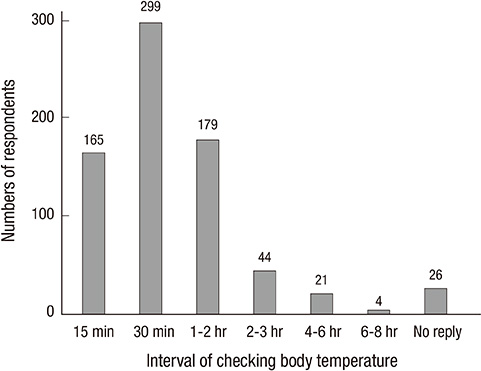J Korean Med Sci.
2013 Nov;28(11):1639-1644. 10.3346/jkms.2013.28.11.1639.
Fever Phobia in Korean Caregivers and Its Clinical Implications
- Affiliations
-
- 1Department of Emergency Medicine, Seoul National University College of Medicine, Seoul, Korea.
- 2Department of Emergency Medicine, Soonchunhyang University Seoul Hospital, Seoul, Korea. emedhy@schmc.ac.kr
- 3Department of Emergency Medicine, Gachon University Gil Hospital, Incheon, Korea.
- 4Pediatric Emergency Center, Department of Emergency Medicine, Asan Medical Center, Seoul, Korea.
- 5Department of Emergency Medicine, Dankook University College of Medicine, Cheonan, Korea.
- 6Graduate School of Medicine, Department of Social and Preventive Medicine, Inha University, Incheon, Korea.
- 7Department of Emergency Medicine, Ajou University School of Medicine, Suwon, Korea.
- 8Department of Emergency Medicine, Seoul National University Bundang Hospital, Seongnam, Korea.
- 9Department of Emergency Medicine, Seoul Metropolitan Boramae Medical Center, Seoul, Korea.
- 10Department of Emergency Medicine, Inha University College of Medicine, Incheon, Korea.
- KMID: 1777662
- DOI: http://doi.org/10.3346/jkms.2013.28.11.1639
Abstract
- Fever is the most common complaint among children brought into the emergency department (ED). 'Fever phobia' is a descriptive term for an unrealistic concern about the consequences of fever. 'Fever phobia' is prevalent among parents and even healthcare providers, worldwide. The aim of this study was to determine the implications of fever-phobic ideas in Korean caregivers. A prospective, multi-center survey was conducted on Korean caregivers who visited the EDs with febrile children. In total, 746 caregivers were enrolled. The mean age of the subjects was 34.7 yr (SD+/-5.0). Three hundred sixty respondents (48.3%) believed that the body temperature of febrile children can reach higher than 42.0degrees C. Unrealistic concerns about the improbable complications of fever, such as brain damage, unconsciousness, and loss of hearing/vision were believed by 295 (39.5%), 66 (8.8%), and 58 (7.8%) caregivers, respectively. Four hundred ninety-four (66.2%) guardians woke children to give antipyretics. These findings suggest that fever phobia is a substantial burden for Korean caregivers.
Keyword
MeSH Terms
Figure
Reference
-
1. Kwak YH, Kim do K, Jang HY. Utilization of emergency department by children in Korea. J Korean Med Sci. 2012; 27:1222–1228.2. Crocetti M, Moghbeli N, Serwint J. Fever phobia revisited: have parental misconceptions about fever changed in 20 years? Pediatrics. 2001; 107:1241–1246.3. Schmitt BD. Fever phobia: misconceptions of parents about fevers. Am J Dis Child. 1980; 134:176–181.4. Karwowska A, Nijssen-Jordan C, Johnson D, Davies HD. Parental and health care provider understanding of childhood fever: a Canadian perspective. CJEM. 2002; 4:394–400.5. Sakai R, Okumura A, Marui E, Niijima S, Shimizu T. Does fever phobia cross borders? the case of Japan. Pediatr Int. 2012; 54:39–44.6. Taveras EM, Durousseau S, Flores G. Parents' beliefs and practices regarding childhood fever: a study of a multiethnic and socioeconomically diverse sample of parents. Pediatr Emerg Care. 2004; 20:579–587.7. Betz MG, Grunfeld AF. 'Fever phobia' in the emergency department: a survey of children's caregivers. Eur J Emerg Med. 2006; 13:129–133.8. Purssell E. Parental fever phobia and its evolutionary correlates. J Clin Nurs. 2009; 18:210–218.9. O'Neill-Murphy K, Liebman M, Barnsteiner JH. Fever education: does it reduce parent fever anxiety? Pediatr Emerg Care. 2001; 17:47–51.10. Tessler H, Gorodischer R, Press J, Bilenko N. Unrealistic concerns about fever in children: the influence of cultural-ethnic and sociodemographic factors. Isr Med Assoc J. 2008; 10:346–349.11. Walsh A, Edwards H, Fraser J. Influences on parents' fever management: beliefs, experiences and information sources. J Clin Nurs. 2007; 16:2331–2340.12. Enarson MC, Ali S, Vandermeer B, Wright RB, Klassen TP, Spiers JA. Beliefs and expectations of Canadian parents who bring febrile children for medical care. Pediatrics. 2012; 130:e905–e912.13. Alpern ER, Alessandrini EA, Bell LM, Shaw KN, McGowan KL. Occult bacteremia from a pediatric emergency department: current prevalence, time to detection, and outcome. Pediatrics. 2000; 106:505–511.14. Hsu K, Pelton S, Karumuri S, Heisey-Grove D, Klein J. Massachusetts Department of Public Health Epidemiologists. Population-based surveillance for childhood invasive pneumococcal disease in the era of conjugate vaccine. Pediatr Infect Dis J. 2005; 24:17–23.15. Williams A, O'Rourke P, Keogh S. Making choices: why parents present to the emergency department for non-urgent care. Arch Dis Child. 2009; 94:817–820.
- Full Text Links
- Actions
-
Cited
- CITED
-
- Close
- Share
- Similar articles
-
- Fever Phobia: A Survey of Children's Parents in a Pediatric Outpatient Clinic
- Subtypes of Social Phobia and Clinical Implication of Offensive Subtype
- An analysis of caregivers' preference regarding fever management in the emergency department
- Factors Affecting the Number of Emergency Department Visits by Caregivers of Children with Fever
- Parental response, recognition and management about fever in children


